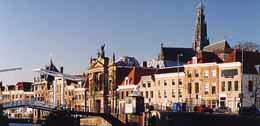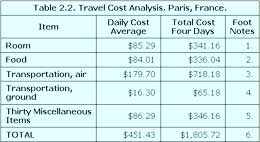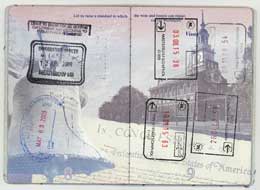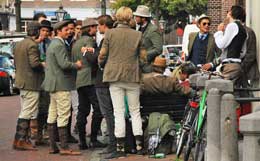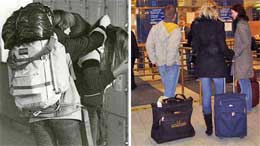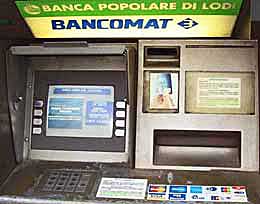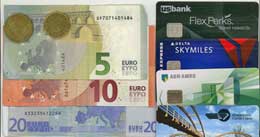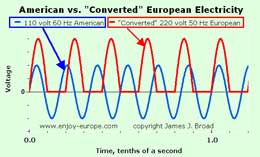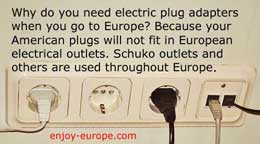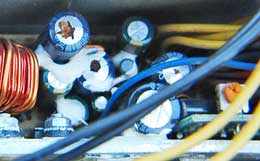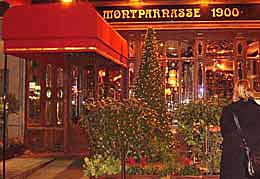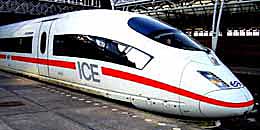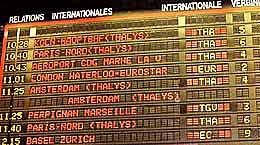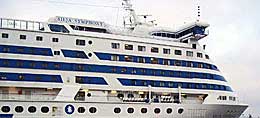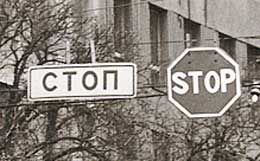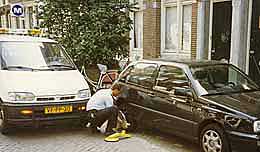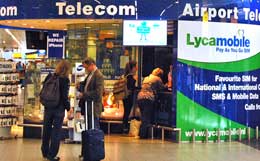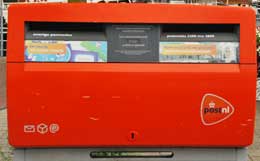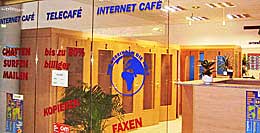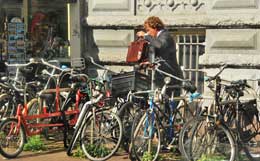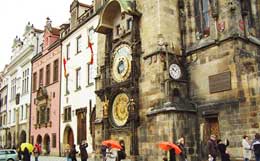Moving to Europe?
International shipping and finding a home in Europe.
How to move to Holland, France, Germany, and Switzerland.
My first home in Europe was the ground floor apartment of the 300 year old house with the black door, on the right. This is the Spaarne River in Haarlem, Nederland, 11 miles west of Amsterdam. Haarlem is a charming but active city of 150,000 people.
My room with a view of the formerly typical Dutch counterweighted lift bridge was conveniently located a two minute walk from one of the oldest brown bars in Haarlem. Above the rooftops rise the spire of Sint Bavo Kerk (a.k.a. de Grote Kerk, "the Big Church"), the winged statue above the Tyler's Museum, and the peak of de Waag, the mediaeval weigh house.
I rode my bike or drove the car to work. Shopping and the train station were short walks. Finding this place to live was not easy but it was nearly ideal. I took this photo on my latest return visit in August 2015. Holland gets better every year.
Carpe diem. Vivere bene! Gratia Deo.
This is chapter 22.1. The entire book is published free on-line by the DIY traveler, author, photographer, and webmaster —yours truly— with help from my daughter Stephanie and good friend Paula in Haarlem, Netherlands. Questions, comments, complaints, and contributions are welcome. Please click footnote. Patronage at my euro-shoppe™ keeps this site on line. Updated .
Been There — Done That — Lessons Learned.
This Internet edition of chapter 22 is presented in two parts plus a special supplement consisting of an email from a high tech reader in Ireland. Thank you Dave.
- 22.1 Moving to Europe?
- International shipping and finding a home in Europe.
- 22.2 Living in Europe
- Daily life in Holland, Germany, France, Switzerland.
- Dave In Ireland
- Technical Details for Moving to Europe.
Here are some other chapters which you may find especially useful before you move to Europe.
- 21 Working in Europe
- Get Paid to Travel
- 11.2 European Voltage
- 220 Volt Electric Outlets and Adapter Plugs.
- Prime Travel Data
- Elementary Travel Information for Europe.
MOVING YOUR PLACE ON EARTH
The nuts and bolts, and screws, of moving overseas present a rather formidable challenge. Having done it half a dozen times, and now planning my final move, I thought I would pass on some know-how for those who are thinking about it. This is a life altering experience, though it may not seem so at the moment. You never know what you are getting into until you get in it, or out of it. For me it has led to writing my book, How To Europe: The Complete Travelers Handbook and this travel web site. That is quite a turn from a career as a chemical engineer.
Many people are called on by their employer to pack up and move to some place on the other side of the planet. They abandon homestead, family, and friends to answer the call, whatever it may be. Some are called by their inner spirit to flee Midland City, USA and just get out of here. I have been called by employers three times and by my inner spirit several more.
Moving to Europe is not an easy task, not at all, but consequently it has its rewards. You have to live somewhere, so why not live it up. Because you are reading this essay you are obviously thinking about moving "over the pond" (I hate that expression). My bet is that you will never regret your move no matter what challenges you meet and master. But you will forever regret it if you do not make the move.
This chapter 22 part 1 concerns getting ready, packing, moving, finding a new home, and other start-up issues, e.g., electricity, heating gas/oil, cable TV, etc. Next, part 2 covers everyday living, as compared to middle America. There are many differences in Europe. The special supplement from Dave in Ireland has critical information for those bringing electronic devices to Europe, especially televisions.
In case you missed it, my chapter on getting a job in Europe so you can support yourself and contribute to the tax collectors, theirs AND ours, is at Working in Europe: Get Paid to Travel.
PERSONAL EXPERIENCES
Europe is a big place, but in truth it is many many places. With about as many sovereign countries and different languages as we have states in the USA, a population greater than the United States by a good margin, and a land area more than double that of ours it is impossible to offer a definitive guide to every country in a small chapter of a general introductory book. However, many facets of life in different countries are similar, and they are different from ours. The following observations will serve as an indication of the kinds of things you will experience as an American moving to and living in Europe.
I moved to Europe four times, maybe six or seven depending on how you define "move." I lived in Holland for about four years in three stints, working about half of that and hanging out for the rest. I lived and worked in Germany for two and a half years in a key role for a major German corporation. I studied French and enjoyed Paris for about six months on two occasions in mid-life, my sabbaticals. Under radar I lived and worked in Switzerland sans sanction for two months. Some of these have been do-it-myself efforts. The first Holland move was partially assisted by my American employer, and the German relocation was a full enchilada company sponsored family move. I also lived and worked in Arabia for a year, but that is another story.
GETTING PREPARED
Moving overseas is a lot more complicated than moving across the country. You must decide what to bring with you because you will find it virtually impossible or incredibly expensive to get anything from home after you have moved.
Big decisions have to be made, probably in short order. If it is a job transfer your company will be the unusual one if it provides more than cursory guidance. Your company relocation specialist has probably never gone through the process of moving overseas, and most likely has never even been in Europe. So assume that you are on your own. The best help and advice you will get is probably going to come from "unofficial" sources.
If you are dreaming about studying or retiring in Europe then start early. Give yourself a couple years of planning time. Study the books and websites on the subject and the country you are heading for. Do not assume that any website, including this short monologue, has all the bases covered. If you have questions or suggestions please see NOTE TO READERS below.
Ex-pat Assistance
There are thousands of Americans living in Europe. Virtually every country has a sizable community of expatriates, some of whom have been there for years. Most of these "ex-pat" residents are working over there, or, at least one member of each family has a job.
Spouses are not likely to be working because of official restrictions. This has contributed to the establishment of American Women's Clubs in many parts of Europe. These clubs can be extremely valuable in providing information for new arrivals, and in helping you get established in the community. As an example of the information you can obtain, the American Women's Club of the Taunus e.V. has published a 200 page book titled Living in the Frankfurt-Taunus Area. This book goes into the nitty-gritty of so many things that I can't even begin to list them here.
Before you move over, try to find out if there is an American Women's Club in your area and get in touch. Order their local guidebook(s) and pay for priority mail delivery. For me, one of the important items in the AWC book is advice on bringing over some foods, e.g. your favorite peanut butter. Holland is the only country in Europe where I have found peanut butter that is not saturated with sugar (in the USA the label calls it "high fructose corn syrup" which is chemically modified corn starch). Other things that I would bring over are heavy duty aluminum foil and an assortment of your favorite Ziploc bags. Ziploc bags are available in Europe but the selection is not as great as it is at home. See chapter 6, Travel Supplies for Europe: Small Stuff Packing List, enumerating many other things you may want to bring over.
FINDING A HOME
Finding a home is the most "fun" you'll have in moving over there. I've done it several times. This section focuses on renting since you are not likely to be buying a home or apartment for a stay of less than five years.
A home can be a house, an apartment, or a room. A furnished house is almost impossible to find in Europe except for short term vacation rentals. A furnished apartment is more likely. Renting a room usually means furnished.
Most rentals are offered by real estate agents. Agents have window displays describing their listings, sometimes with a photo. They also advertise in the daily newspapers. There are usually just as many newspaper ads from people seeking apartments as there are listings for available apartments. There is a large difference between the prices of offered rentals and those requested.
Furnished/Unfurnished
When renting, you will be looking for furnished or unfurnished diggs. Furnished places are not easy to find, and when you find them, they are usually quite extraordinary in arrangement and furnishings.
Unfurnished places can be extraordinary in another way — unfurnished! In Germany a typical unfurnished rental won't have a closet (Schrank) in the house, nor a kitchen sink, counter, or cabinets. Light fixtures and switches are scarce. Moving in may require purchase of stand-up closets for your clothes and installation of a kitchen. Thanks to higher prices for nearly everything in Europe, getting these essentials can easily cost you several months salary. We were lucky that the owner already had a furnished kitchen in the German house and offered to sell it to us. It was old but functional so we took it.
Holland
I went to Holland as a single man at the same time as a half dozen other people from my company. The company advised us to use a makelaar (real estate agent) to find a house. None of us could read the Dutch papers and had no help whatever from our company, a major international engineering firm.
Three of us took a small furnished place and temporarily camped in for a few weeks. Each of us had different needs and different makelaars to locate a home. Mine showed me furnished apartments and rooms, all priced about twice as much as a Dutchman would pay. Some were rather unusual. One was in an office building with the toilet and shower two floors below my room. In another, in a private home, I would have had to walk down some stairs and up some others to get to the kitchen. Dutch stairs are similar to ladders.
I finally got lucky with a ground floor furnished apartment in the heart of Haarlem for a reasonable price. The owners also had a makelaar, so theirs and mine got together to draft the contract and collect their fees. The apartment had everything. The inventory list was three pages long. The owners lived upstairs and insisted that I also use their maid on a weekly basis. One remarkable thing happened as I moved out. My makelaar could not find one of the items on the inventory list, and in fact didn't even know what it was. The owner helped out. The missing item was a plastic spoon. I had long ago thrown it in the trash!
France
On moving to Paris I went over on my own and took a hotel room while I looked for a place to live. I checked the postings at the Alliance Française, Shakespeare & Company bookstore, American Church, and newspapers. After looking at a number of unsightly cheap places I got lucky on the Left Bank and found a one room efficiency apartment in the Quartier Latin near the Metro stop Maubert-Mutualité. The owner of the apartment, an American expatriate, lived in another apartment in the same building. She rented it monthly, rather a rarity in Europe. It was fully furnished, complete with TV and kitchen utensils. The utilities were all hooked up including the telephone. It was ideal for a few months during my bachelor days in the summer of '86. That was where Elizabeth came into my life.
Elizabeth went back to Europe a few years later for more research on my book. She based in Paris but had some difficulty finding a low cost apartment for a short period. Finally she found a small place in Boulogne-Billencourt, a suburb in the southwest skirts of Paris. It was not furnished except for the stove and sink. She installed the telephone, got the electricity hooked up, bought a refrigerator and TV, pots and pans, and everything else. For six months it was livable and cozy. From there we made our first expedition to Budapest while the commies still ran Hungary.
Germany
My company's transfer policy for Germany included a house hunting trip prior to our move. It didn't quite work out that way. The trip became a week long series of presentations to the "American delegation" by the German bosses and staff. The company personnel office was to have helped us find homes, but it didn't work out very well. The German personnel office was given totally wrong information about our needs, thinking we were all single guys who could live in just about anything. Actually most of us were married and a couple of us had families.
So much for corporate communication. I quickly learned to deal with it. After a couple days of being led to oddly configured apartments and rooms in private homes, I took matters into my own hands. I bought some city maps and daily newspapers from the surrounding Dorfs and went out on my own hunt.
Rentals are handled by a Grundstückservice (real estate agent) in Germany. After selecting my city, it was easy to view a few houses after work every day. A few days of intense searching turned up a beautifully situated old house in Aschaffenburg. My company signed the contract, paid the agent, and gave us the keys. We contacted appropriate utility offices and had the electricity and telephone lines transferred to our name with no trouble.
About every six months we had to order oil for the furnace. There were three large oil tanks in a room in the cellar. Once a year the city chimney sweep in traditional black coat and hat came around, unannounced, to clean the chimney. When I saw the guy the first time I thought for a moment that we were in a Dickens' novel — he was right out of the book.
Fortunately the oil tank room was big enough to fit in our wine racks. It was the perfect dark cool place to let our wine rest. We drove over to Burgundy in France every six months to fill the trunk with wine en vrac which I would bottle in our cellar. This was certainly one of the delicious benefits of our transfer to Germany. See the picture in chapter 23 at Burgundy wine for more information, though this photo was taken later when I lived in Holland again. For more information about German wine see my essay on this nice beverage at German Wine Labels: Taste and Spit
Lease
Your lease will be in the local language. I couldn't read the Dutch contract but I signed it. In Germany I couldn't read that one either but the company personnel director signed it. When signing I recommend that you have your lease translated into English so you know what the deal is.
We tried to get out of our lease in Germany after an incredible storm flooded our lower floor. I love storms and was so amazed that I made a video of the ominous black clouds and driving sheets of rain. It was the mother of all storms. Little did I realize as I filmed her upstairs that she was giving us the works downstairs. Our lower floor was a mess, but all we lost was the carpets. This was inexplicable because we lived on a 100 foot high bluff overlooking the Main River.
The owner went from smiling nice guy to extreme nasty. He fixed the immediate cause of the flooding, but the situation was basically nonrepairable unless a much larger storm drain would be installed by the city.
If you are planning to permanently settle in Europe then you would probably want to buy your own place. Real estate agents are just about everywhere and their windows look just about the same everywhere. They are decorated with photos of available properties with some basic statistics and the price. This agent in Lyon, France has a number of available apartments. One in the center is offered for €475,000. The floor space is given as 140 square meters, about 1,500 square feet. You will surely want to shop around, and make sure that the place you choose has a garage. Parking is the supreme challenge when living in any reasonably sized city in Europe.
See chapter 18, part 4,
Parking, Gasoline, Safety
THE MOVE
If you are moving to Europe there are several ways it can be done. Those being transferred by their employer will find it rather simple in most cases. Moving companies will be arranged and you follow the directions. Single people are treated rather off-handedly I found, while families are given better consideration and benefits. Do-it-yourselfers can save thousands of dollars by using freight forwarders. Pack your own and bring your things directly to the dock.
Single Status
My first relocation to Europe was on single status. My company gave me a plane ticket and $240 and told me to report for work in The Netherlands in a couple of weeks. I left almost everything I owned with my brother. I packed my clothes and computer and brought them to an air freight company. I drove my car to the dock and turned it over to the freight forwarding company, took a taxi to the airport, and flew to Holland.
On my self-made transfer to France, I sold most of my household stuff, sold my cars, stored my books and computer in my office, stored a few big items in a self-storage locker, filled a couple of suitcases with clothes and flew over. I had done something similar when I went over for six months while working on the first edition of this book.
Family Status
Our transfer to Germany was far more involved. With a wife, two year old daughter, tons of furniture, and a three year stay expected, my company provided just about everything they could to make it as easy as possible. The transfer policy called for a professional moving company. Estimators came and surveyed the job. The low bidder got the job and came back a few weeks later with instructions on how we should prepare. The agent left a load of papers to fill out. They showed up on schedule and packed it all directly into a 20 foot ocean shipping container. We took the shuttle bus to the airport and flew to Frankfurt. The moving company, German branch, drove the container up to our house in Aschaffenburg about two months later and unpacked everything.
Moving Day for a House Full of Furniture
Before the movers show up, you should have filled out your inventory and insurance papers for the items which are going on the ship and those that are going into storage.
The mover will show up with an ocean shipping container, a truck full of wrapping paper, and four strong guys. Get ready for the tornado.
The most important thing to do before the arrival of the mover is to pack your suitcases, briefcase, and purse and get them into a safe place out of sight of the four strong men. Say, lock them in a closet. They must be convenient for access, but not convenient for packing. My movers have told me about incidents where air tickets and passports have been packed in the sea container. If this stuff is on the boat, you are going to have one heck of a problem when you get to the airport. You might think that the packers will be thinking that he shouldn't pack a purse or briefcase, but if your family is like ours there are a dozen purses and a few briefcases laying around. How is he supposed to know what is what? When you tell him that a room is ready to pack, EVERYTHING gets packed. One of my souvenirs of Europe is the empty box that our German telephone came in. It was carefully wrapped and shipped just as it was found by one of the four strong guys, and is now wall art in my home office.
Also pack and get your valuables out of sight of the movers. Packers and moving men can succumb to temptation and pinch items they like. You won't know it until you are a world away months from now so it is hard to catch the thieves and prosecute them. On various moves in California and Germany I have lost some favorite shirts, dust collectors, a book of beautiful Russian stamps bought in Poland, and a credit card. I wasn't aware that the credit card had been stolen because I have so many of the darn things. A year after my move I started getting calls to pay my bill. They had tracked me down at my new job. Someone had used the card to buy a set of tires. I told them to call the sheriff, several times, loudly. Eventually the calls stopped.
Overseas Delivery
When the container gets to the destination, you have an empty house that will quickly be filled with your bulky wrapped stuff, and it's not Christmas. As the movers bring things to the door they will want to know which room to go to. Try to make sure that all boxes are adequately marked when they are packed, i.e. "kids bedroom," not just "bedroom.". You will be busy checking off item numbers on the inventory list and it can get hectic with four guys nearly running in and out with hundreds of boxes. For big and heavy items, they will also want to know where in the room something belongs.
When everything is done, at both ends, it is customary to tip the movers and packers. How much? The job is done, so you know how things went, sort of. If you talk to the men about the tip, they will brag about the thousand dollars they got from some company president last week. Of course his family probably had an expensive lot of furniture. We gave a couple of hundred dollars to the packers at each end, and a lesser amount to the crews which unloaded. The packers worked for three days while the unloaders finished in a day. We also gave the German packers a beer during their break periods. Germans love their beer.
HOUSEHOLD ITEMS
Except for electrical items (more about that next), ship everything you have and use.
Moving overseas is far more complex than a domestic USA move where you might just rent a truck and do it yourself. I suggest that you get professional expertise on your team.
If your company is shipping you they may have limits on the amount or types of items. For example, they'll probably not pay for shipment of boats and horses and other bulky pleasure items. Initially they told us we couldn't ship our piano but I prevailed on that one. Ocean shipping costs are based on volume, not weight, so it actually cost less to move the piano than a couch.
Electrical Items
You can find most of the important points on this subject and devil's details in chapter 11, European Voltage: 220 Volt Electric Outlets and Adapter Plugs. Plug into that chapter again.
Transformers
When buying transformers to operate 110 volt appliances in Europe, select one that is rated about twice as high as the total power requirement for the devices which you plan to use it on. That is, if you have a 200 watt stereo and a 100 watt computer, buy a 600 watt or higher transformer. There are several reasons for doing this.
One reason is that all appliances use much more current during start-up. When you turn something on the "in-rush" current can be five times as much as operating current, though it lasts for only a fraction of a second. If you have your computer running you don't want another device sucking up all the electrons for even an instant.
Also, there are no "official" standards for specifying, designing, or manufacturing transformers. The nameplate is whatever the manufacturer wants to say. Some transformers claim to be "continuous duty." That is like saying the sky is high. All transformers can be used on continuous duty as long as they do not get hot. The ultimate definition of "hot" in this context is that they do not burn up the insulation. A practical definition is that you can press your hand to the transformer for a few minutes without screaming.
Converters
See European Power Adapters:Do Not Use an Electric Converter in Europe.
Motorized Appliances
Major electrical appliances such as refrigerators, washing machines, dryers, ovens, and dishwashers are special cases. If you bring these with you then you will need a transformer with enough power to get them running. You need a 220 to 110 step down transformer sized for at least twice the wattage of the appliance. Actually, your electric oven may already be rated for 220 volts. It eats a lot of power.
European frequency is 50 Hz and ours is 60 Hz. Practically speaking, all items with a motor will run slower over there due to the lower frequency. This generally applies to stereos, tape decks, dial face clocks, and many other items. If the electrical nameplate does not state 50 Hz you should be prepared for some kind of less than optimum performance, and maybe the doom of destruction.
A possible exception to the general rule is your hair blower. It might work satisfactorily over there if it has a dual voltage switch.
I wasn't so smart when the company transferred the family to Germany. We left all our appliances in storage in California. That meant buying all new ones in Deutschland. The $3,000 which my company gave us for this expense covered only half the cost. Everything is about twice as expensive in Germany.
You can buy 220 V 50 Hz appliances at a few specialized stores in the USA. Many household items are basically the same as in Europe, so the only difference is that a special retrofit company changed the motor and attached a new cord with the European plug.
Normally that is the end of it. There is an exception. If you ship a washing machine you also have water to connect. American washers have connections for hot water and for cold water. European washing machines normally have only a cold water connection and an internal electrical heater to give the exact temperature you dial in. So, when you go to hook up your American washer in the utility room of your European home, you might need to run some new hot water piping also.
It might be better to buy a washer over there. The downside of this is that it will be smaller and it will take much longer to wash your clothes. The normal wash cycle in Europe includes an hour or so of soapy soak time, which is probably more efficient than the American way. We lucked out in Germany because the house had a washer and the owner offered to sell it to us at a reasonable price, "reasonable" for Germany that is.
Lamps
Take all of the light bulbs out of your regular lamps, but bring the lamps with you. European current is at 220 volts so all your American bulbs will flash and burn out pretty darn quick on the higher voltage. Most European bulbs will screw into the socket so you will be able to use your lamps with European bulbs. The European standard is an E-27 socket, meaning that it is 27 mm in diameter. American sockets are E-26, 26 mm in diameter. They are close enough that they are interchangeable. All you need is a simple plug adapter for the line cord. Buy a supply of these before you go.
Power Strip
You might want to use a power strip. Do not use American power strips rated for a maximum of 110 volts, unless you want to see a troop of fellows outside with water hoses in hand, standing next to a big beautiful truck displaying all sorts of flashing lights.
Halogen lamps operate on a 12 volt direct current voltage. They come with a small transformer brick which plugs into the wall socket. Bring the lamp and bulb to Europe and buy a replacement transformer brick in an electrical store on arrival.
TV
Televisions, VCRs, and DVD players are special cases. The electrical requirement is not the major problem. It's the broadcast system. All American televisions operate on the NTSC system. (I don't know, need to know, or even care to know what these and the following acronyms stand for.) In Germany, the PAL system is in use. In France, the SECAM system is in use. There are other systems in other countries, sort of like different languages. The net effect is that an American TV is nearly useless in Europe. You can tune in to AFN, the American Forces Network, if you are living in the vicinity of an American military base. Most of these bases have disappeared since the Gulf War in 1991.
Dish or cable? If your area already has cable you have a decision to make. Talk to others and find a deal that suits your interests. If there is no cable in your neighborhood you will almost certainly want a dish. Of course it must have a clear view of the satellite so this is an item you should consider when choosing your domicile. There are many dishes hanging from the walls of apartment buildings throughout Europe and they are aimed at a very low angle. If you are forced to use an antenna you won't be seeing much.
Many of the televisions sold in Europe are "multi-system." This means that with the flick of a switch they can be used in various countries. We bought a multi-system TV and VCR in New York before going to Germany. This was a very expensive TV but still it cost only about half as much as the same model in Germany. There are a couple of flat screen multi-system TVs advertised in the pink column on the right.
DVD players are also country or region specific. However multi-system units for this format are available so you can bring your movies to Europe and buy a multi-system DVD player.
Radios operate OK, so long as they follow the general rules on voltage and frequency. Radios with digital tuning will be an annoyance if the signal from your favorite station is weak. You are better off with an old fashioned analog tuner. If you subscribe to cable TV you will probably be able to plug your FM tuner into that.
Telephones
Telephones are much more expensive in Europe so this would be a good item to bring with you. We bought a phone in New York and had no trouble with it in Germany.
Telephone dialing can be "tone" or "pulse." Pulse is the old system where the number is sensed by the time it takes a dial to turn back to stop. Tone uses a different frequency tone for each number. It is much faster to dial tone.
Push button phones can be used on a pulse system. If you are on a pulse system you will have a little bit of difficulty when you dial a business and receive an automated response with a choice of menu items. These systems do not recognize pulses. If you are on a pulse system and connect to one of these businesses, switch your phone to tone after you connect. Then you can use the menu. When you hang up switch it back to pulse or you will not be able to dial.
Some of Europe is still on the pulse dial system, whereas most of the USA uses tone dialing since the introduction of push-button phones. Most phones sold in the USA have a "tone-pulse" switch so they can be used almost everywhere. If you have a speaker phone or a remote handset type, the phone will need an electrical connection. Make sure it is rated for 50 Hz and then plug it in with a transformer to reduce the 220 v to 110 v.
Fax Machines
Fax machines are also more expensive in Europe so bring yours over. If you don't have a home fax machine this would be a good time to consider an investment.
Dialing is the same as telephones. A home fax machine is particularly nice to have over there for speedy and cheap communication. A whole typewritten page can be transmitted within seconds at a cost way less than an airmail stamp from Europe. If you use a discount phone system you can send a one page fax for about ten cents. This may be cheaper than an email, especially if you compose on-line in Europe. My fax machine runs on 110-220 volts and 50/60 Hz. It's actually a combination printer, faxer, scanner, and copier.
Computers
American desktop computers and peripherals may or may not operate properly in Europe. Check the name plate to see if it will operate on 220 volts and 50 Hz. The frequency is the major problem. If it is not stamped for 50 to 60 Hz you are taking a risk by bringing it to Europe. If it accepts 50 Hz, but only 110 volts, you can use a transformer to convert European current to 110 volts for your machine. There is no cheap way to convert 50 Hz to 60 Hz. Most computers operate at both frequencies and at both voltages, but some monitors only operate on American 60 Hz frequency. I bought a computer monitor in Germany which is rated for both voltages. I operated my laser printer with the aid of a 750 watt transformer.
Laser printers are dinosaurs now and the newer ink-jet style printers use much less power. Also they have a electric brick which is usually rated for 110-220 volts and 50/60 Hz. Therefore all you need is a plug converter for whichever country you are moving to. On top of that the geniuses at the computer printer companies have figured out how to make a machine that does four jobs — prints, copies, faxes, and scans. Wow. I have one of these, an HP Officejet J6480 All-in-One. It was a great device for my home office, for about 10 years. Then it started falling apart. I guess that HP doesn't want to be making stuff that really lasts or they would loose their market.
Laptop computers normally operate on 110-240 V and 50-60 Hz. Check the electrical nameplate on the bottom. In this case all you need is an adapter plug.
Batteries
Devices which operate on rechargeable batteries are no problem, but the battery charger might be. Brands like Panasonic and Sony can operate worldwide on 110 to 220 volts and 50 to 60 Hz. Check the name plate.
AUTOMOBILE
The biggest item you probably want to move is your automobile. Just about eight months before my first move to Holland I had bought a new car, a beautiful white Porsche 911S. Selling it would have meant a large loss so I shopped around for the best way to get it over there. Even if your company will not pay for auto shipment, it may be best to ship your personal car because cars are so expensive over there, and you're going to be faced with buying another one when you get back to the USA. I shipped my Porsche to Holland and I'm happy I did. The funny thing was that the Dutch National Police also drove Porsches, but their's were Targas with the tops off. The Dutch cops are so tall that they could not fit in the car with their helmets on. They almost caught me speeding one time.
Before driving too far into this please read chapter 18. It is in four parts due to the large volume of information, starting at Driving in Europe: Back Alley to Blazing Autobahn.
Shipping Your Car
The procedure is rather simple. Contact an international shipping company. Give them the weight, length, height, and width of the car, make and model, serial number, and license. They will quote a price for freight and for marine insurance. (Your auto policy stops at the pier.) Pay up and then drive to the port on the assigned day. This will be about three days before the scheduled departure of the ship. Make a thorough inspection with the shipping agent for existing dents and scratches, and itemize all accessories on the insurance document. For instance, list the tool kit, spare tire, car cover, and any other loose or easily detachable items. You won't be allowed to ship items such as appliances and clothes in the car because they will probably disappear. My car, shipped in a container both ways, suffered not a scratch. However, a port worker in Long Beach on the return stole my auto compass and drained the battery listening to the stereo.
Even though it is simple to ship your car through an international freight forwarder you may not want to do all the work yourself. For example, driving to the port may be a major inconvenience, especially since you have a hundred other things to do in preparation for your move. You can have door to door service through A-1 Auto Transport, specialists in shipping autos and other vehicles internationally. The A-1 Auto Transport web site provides important up-to-date information, especially regarding insurance and potential taxes and fees.
Retrieving Your Car
When picking up your car at the port in Europe, bring your original bill of lading, passport, auto title, green card (all-risk insurance), driver's license, International Driving Permit, a few liters of gasoline, your keys, window cleaner, towel, and some local money. You need them all.
The original bill of lading will be mailed to you by the shipping agent some time after the ship departs. You must give the agent an address in Europe or wait at home until you receive it. The bill of lading is in triplicate, but you only need the original to claim your vehicle.
Port authorities are supposed to disconnect the battery and drain the gas tank before putting the car on the ship. However, it is up to you to get your car going again. So bring a few liters of gas when you go to the port. The car will be decidedly filthy after weeks at sea, so clean the windows before driving out of the Customs warehouse.
And there is always one more tax to pay, so bring a hundred dollars in local currency to bail out your wheels. My fee was about $17, but I have heard of much higher charges even though "door to door" service was paid up.
Customs
There might be some problems vis-a-vis Customs, or perhaps other tax collectors over there. You will get different stories from different officials regarding these topics, all of which have to do with prying money out of your pocket. After living in Holland and driving an auto with California plates for two years, I still didn't know whether I was legal or not. I kept my California registration up to date and told the police each time they stopped me (curiosity questions, not violations) that I was bringing the car home with me when I left Holland. I had no inkling of trouble until three weeks before I left when I heard from a third party that the police planned to confiscate my car because I had not paid Dutch road taxes. Wow! Panic! It took some Sherlockian efforts to find out which policeman was going to do this to innocent me, and after some discussion, he agreed not to take my car if I was going to take it home to California in three weeks. Yes sir, it was on that boat.
Have Car - Must Have Garage
For my move to France, I decided that it wasn't practical to bring a car since I planned to be in Paris for most of the time. I used the public transportation system. A major detriment to having a car in any major city is finding a place to park it. If you bring your car to any major city you will need a private garage.
Besides having a parking place a garage offers security. The youth mobs of Paris burned hundreds of parked cars in their riots for jobs or whatever. I had no garage in Holland and parked my Porsche on the street in Haarlem every night. It was vandalized three times in two years. Some idiot ripped the antenna off my company Opel in Aschaffenburg, Germany. We had a garage but I didn't use it for the car. It was for the bicycles and other stuff.
Warranty
Another annoyance in bringing your car to Europe is that the warranty will probably be invalidated. European car warrantees are normally issued by the American importer, not by the factory over there. So if your car is still within warranty, make up a moan list of squeaks and rattles to get fixed for free before shipping it overseas. Check the owner's manual or phone an authorized dealer to review your warranty rights.
Company Car
For our move to Germany, the company I worked for refused to ship our car but offered to compensate us up to "blue book" value for it. I was given complete use of a company car while I was over there. So we sold ours before we left. Nevertheless, we wish that we had shipped the car over at our own expense. It would have been very handy to have a second car in the city where we lived, especially when you have a small child. We never got around to buying one over there because of the high cost of cars in Germany.
Plan Ahead
The bottom line is the bottom line. If you have a relatively new car and you are going for a couple of years it would probably be best in the long run to ship your car over. That would likely be less expensive than selling it and buying another one when you get home, or of paying for storage and buying/reselling a car while you are overseas.
JUST BEGINNING
This chapter is in two parts due to its large size. Now you can click to Part 2 to see what it is like living in Europe.
Have a good trip!
Selections at
#E-010
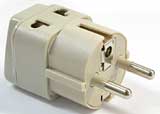 Grounded Universal 2 in 1 Plug Adapter
Grounded Universal 2 in 1 Plug Adapter
European Schuko plug.
4.8 mm prongs.
Equivalent to type E and F.
You can use this ungrounded Euro plug in many European countries.
#E-020
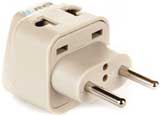 Universal 2 in 1 Plug Adapter
Universal 2 in 1 Plug Adapter
Euro Plug
4.0 mm prongs.
Equivalent to type C.
A universal plug adapter for the UK and Ireland.
#E-030 hhh
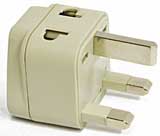 AC Adapter Plug for use in England, Scotland, Wales, and Ireland
AC Adapter Plug for use in England, Scotland, Wales, and Ireland
Equivalent to type G.
Here is the Swiss version.
#E-040
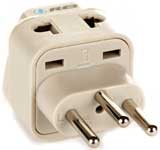 Grounded Universal 2 in 1 Plug Adapter
Grounded Universal 2 in 1 Plug Adapter
Type J for Switzerland
Here is the grounded Italian model.
#E-050
 Grounded Universal 2 in 1 Plug Adapter
Grounded Universal 2 in 1 Plug Adapter
Type L for Italy
Note: The highlighted #E number is arbitrary. It is meant to help identify products in this advert page when you write in for electrical advice.
This 110-250 volt power surge strip has three universal outlets and an American grounded plug so it needs a plug adapter for the countries you are visiting. Make sure that all your gizmos are rated for 110-240 volts.#E-060
 SM-60 Universal 3 Outlet Power Strip Surge Protector for Worldwide Travel. 110V-250V with Overload Protection.
SM-60 Universal 3 Outlet Power Strip Surge Protector for Worldwide Travel. 110V-250V with Overload Protection.
For charging up to six gizmos at a time use this 250 volt universal power strip. It comes with a grounded Continental plug.
#E-070
 Surge Protector
Surge ProtectorPower Strip
6 Universal Outlets
220/240 Volt 50/60Hz
Most gizmos charge their battery through a USB port so this car charger can keep you going as you drive. European cars have the same nominal 12 volt system as American cars. The LED display on this charger shows the voltage, among other things.
 MONKA@4in1 Dual USB Car Charger
MONKA@4in1 Dual USB Car Charger
This 50 watt transformer changes 220 V electricity to 110 V. It works for small devices up to 35 watts continuous service, if they can operate on 50 Hz which is true for many battery chargers. Check your electrical nameplates and refer to chapter 11 for further information.
 50-Watt International Transformer.
50-Watt International Transformer.
Travel Smart by Conair.
For small appliances this transformer will suffice in many cases. It is rated at 200 watts. However, in continuous service it would be best to use it on appliances needing no more than about 100 watts.
 Step Up/Down Transformer
Step Up/Down Transformer
120/240 volt 200 Watt
by Power Bright
Absolutely the best battery for digital cameras which use AA batteries.
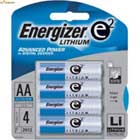 Energizer
EnergizerAA Lithium Batteries
4 Pack
HOW TO EUROPE
The Complete Travelers Handbook
Chapter 1
What's It All About?
Travel Like a Native In EuropeChapter 2, Part 1
On Budget in Europe
Travel Costs: How Much?Chapter 2, Part 2
Europe on WHAT! Per Day?
My Actual ExpensesChapter 3
Passport and Visas
Identity and Travel DocumentsChapter 4
Flying to Europe
Travel Starts at the AirportChapter 5
What to Wear in Europe
Your Best Travel Clothes for Every OccasionChapter 6 Part 1
Pack Light Field Test
Validating Your Europe Packing ListChapter 6 Part 2
Personal Care Items
Pack Your Toothbrush, Toilet Paper, and Vinegar.Chapter 6 Part 3
Travel Supplies
Small Stuff Packing ListChapter 6 Part 4
Bringing Valuables
Not in Your Luggage or PurseChapter 7
Luggage for Europe
Get Wheels. Let It Roll!Chapter 8 Part 1
Pickpockets in Europe
They're EverywhereChapter 8 Part 2
ATMs in Europe
Machines Dispense Travel CashChapter 8 Part 3
Cash and Credit
Paying Your Way in EuropeChapter 8 Part 4
Money Potpourri
Cash, Coins, Transfer, BarterChapter 9
Your Travel Diary
Blog ItChapter 10
Europe Guide Books
Reviews of Tomes for TravelersChapter 11, Part 1
An Electric Converter in Europe
Electric power converters supposedly change 220 volts to 110 volts.Chapter 11, Part 2
Plug Adapters for European Outlets
American plugs do not fit in any electric power outlet in Europe.Chapter 11, Part 3
European Voltage Essentials
220 Volts of Power 50 Hz Frequency.Chapter 12
Photography in Europe
Take Your Best ShotChapter 13
Bring a Smile
Travel Europe in Good AttitudeChapter 14
Hotels, B&Bs, Hostels, Homes
Travelers' Sleep OptionsChapter 15
Eating In Europe
Travel on Thy BellyChapter 16
City Transport in Europe
Bus, Streetcar, Subway, Taxi, Bike, Shoe, GondolaChapter 17, part 1,
Trains in Europe
A Rail PrimerChapter 17, part 2,
European Rail Stations
Finding Your WayChapter 17, part 3,
Night Trains in Europe
Sleeping City to CityChapter 17, part 4,
Boat and Bus Services
High Seas Ferry, Highway CoachChapter 18, part 1
European Auto Rental
Details and DocumentationChapter 18, part 2
Driving in Europe
Back Alley to Blazing AutobahnChapter 18, part 3
Driving Habits and Laws
Police, Speed Limits, TailgatersChapter 18, part 4
Parking, Gasoline, Safety
Adjuncts to Driving in EuropeChapter 19, part 1
Telephoning to, from, and within Europe
City Codes, 10-10, cell phonesChapter 19, part 2
Sending Mail
Priority Mail, Poste RestanteChapter 19, part 3
Internet and Email
Europe's Cyber Cafes and WiFiChapter 19, part 4
Telegrams
Wiring CashChapter 20
Health and Safety
Travel in Confidence but with CautionChapter 21
Working in Europe
Get Paid to TravelChapter 22, part 1
Moving to Europe
Things to Know Before You GoChapter 22, part 2
Living in Europe
Travel to the Max as an ExpatriateChapter 22, Special email
Dave In Ireland
Technical Details for Moving to EuropeFor all 30 chapters and much more see
HOW TO EUROPE
The Complete Travelers Handbook
Free to use but not to abuse.
Copyright:
Internet edition
© 2001-2016 James J. Broad
All rights reserved. Tous droits réservés.
This is copyrighted material. Do not reproduce, copy, plagiarize, re-craft,
store, modify, extract, transmit, or purloin any part of this
publication in any nation in any form or by any means or for any purpose whatsoever without permission
in writing.
Copying:
You may print one paper copy of this web page for your personal use.
Permissions:
If you want to adapt any part of this material to use in your blog, forum, web site, book, article,
speech, term paper, movie, video, or any other media please write to me and get
permission before you do so. Otherwise it is a copyright violation or plagiarism.
Plagiarism includes paraphrasing text and copying ideas. Imitation,
the old saying goes, may be the highest form of flattery. However, plagiarism is outright theft and is usually
compounded by the lies of the perpetrator.
Everything on my web site is original, created at great personal expense
in time and cash in the course of my extensive travels throughout Europe. Please respect my property.
For detailed descriptions of the many forms of plagiarism see
Plagiarism.org and
A Plagiarism Guide for Students.
For permission to use material from this web site contact:
[email protected].
Webmasters:
You may link the URL http://www.enjoy-europe.com/moving-to-europe.htm freely. Please do. When you link please send the URL for your linking page and a crosslink will be installed in one of the categories of the TRAVELERS YELLOW PAGES to your site if it has significant content for travelers in Europe.
Free, free, and free
This web site is totally free for everyone, and a labor of love for me.
Support
To keep enjoy-europe.com afloat I advertise scores of travel related books and products. My site receives
a commission from Amazon.com for all goods purchased through the advert links. These advert links are
displayed on individual pages and on my on-line store at
 . Your support is most gratefully appreciated. TIA.
. Your support is most gratefully appreciated. TIA.
Your Blow Back
I welcome questions, comments, and complaints. If you have any concerns about your trip to Europe that have not been covered well enough on my web site please do not hesitate to write. Ask, cuss, discuss, or whatever. I read every email and update my pages when I see a question repeating,
Utilities:
- How To Europe: The Complete Travelers Handbook.
- Home.
- To the top of this page
- E-Mail to John Bermont
- Meet the Author
- Privacy Policy
- Site Map
- Advertising Policy






